©elfruler 2018
Acquiring accurate measurements of a bird is a tricky business, and it turns out that there are relatively few peer-reviewed publications that report measurements for Bald Eagles. In the pages that follow I present tabulations of the credible numbers of which I am aware. I begin with some general information on measurements and measuring. General References are given at this link.
What are the sources of measurements?
The most reliable measurements are taken from a live, wild, healthy eagle, but capturing one is difficult and rarely attempted. Some researchers have used captive eagles, recently deceased eagles, and museum specimens for measurements, but these present some issues that must be considered:
- Permanently disabled eagles in captivity may have different measurements from those of their cousins in the wild because of richer diets, less exercise, irregular feather molt, abnormal beak length and depth (due to inconsistent feaking), etc.
- A rescued eagle in distress is usually dehydrated and emaciated, so its weight is likely to be lower than normal. After being treated in rehab for days or weeks during recovery, its diet may be richer and more abundant than it would be had the eagle continued living in the wild, which coupled with a reduced level of activity may result in a higher weight than normal at its release.
- A recently deceased eagle can yield accurate measurements unless the eagle succumbed to injury or starvation, or the body has decomposed or been disfigured by a predator.
- Measurements of carcasses that have ended up as prepared skin specimens in museums or other collections can be useful for some features, such as talons, bill depth, wing length, and tail length. But a specimen is subject to drying and shrinkage which can affect some measurements such as total length, bill width, tarsus width, wing chord, wingspan, and individual feather length. And since most bones are absent from prepared skins, weight and most skeletal measurements are impossible. Specimens also can yield erroneous sex classifications, especially with younger birds. (Bortolotti 1984c)
How do researchers measure?
- Scales, calipers, and tape measures are standard tools.
- Digital scales give more precise readings than analog scales. All scales should be well calibrated.
- Methods for positioning the bird on scales and for a linear measurement can be surprisingly challenging and require study of best practices as well as training and practice.
- Measurements are best reported in universally used metric units (grams, millimeters, etc.), although some earlier studies and a few recent ones use the “traditional” American system of pounds, ounces, feet, and inches.
- For ease of comparison, here I use metric units including conversions where necessary.
- For features that incorporate a curve or arc, such as the folded wing, talons, beak, and feathers, the measurement is of the chord, or a straight line between two end points, thus disregarding the curve. Measuring the curve itself requires a calculation based on the shape of the curve and may lead to only an approximate measurement that can make comparisons difficult. Feathers and wings are not rigid and can be flattened to eliminate the curve, but this can introduce inconsistencies or inaccuracies and is generally avoided by researchers.
- Reliable statistical analysis requires a sampling of a large enough number of birds to provide minimum, maximum, and average measurements. The notation “N=x,” where x is the number of birds examined, conveys the size of the sampling. In general the average is the mean. Some researchers calculate a standard deviation (SD).
What features do researchers measure?
P. Baldwin, H. C. Oberholser, and L.G. Worley, Measurements of Birds (1931) established a comprehensive and standardized system of obtaining linear measurements of the various parts of birds, which continues to guide researchers. It includes detailed discussion of procedures and challenges and the tools needed to obtain accurate and consistent measurements, along with drawings showing what to measure, how to position the bird, and where to place the tools.
- Subsequent studies of raptors have offered nuances and modifications necessary for measuring these species.
- The authors of some studies do not always make clear what exactly what they measured or what procedures they followed, or their procedures may not conform to standard practices. For example, some authors do not indicate whether they used live birds or specimens, they may omit important information on the geographical origins, age, or sex of the birds, or they may use unorthodox techniques without explanation.
The following measurements of Bald Eagles have been reported in published literature. (Figures from Baldwin et al. 1931 are used under the license agreement with Creative Commons. Figures from Bortolotti 1984a are used with permission of The Journal of Field Ornithology. Figures from Bortolotti 1984c are used with permission of The Wildlife Society, Bethesda, MD.)
- Weight, which would seem to be a straightforward measurement to obtain simply by putting the bird on a scale. But several factors can skew the reading, and researchers do not always indicate whether they have addressed them:
- A malnourished or otherwise unhealthy bird.
- Contents of the stomach and crop, which can vary widely from hour to hour or day to day (according to Gerrard & Bortolotti 1988, a Bald Eagle’s crop can hold about 15% of its body weight). A desirable reading would be a “net” weight with empty stomach and crop.
- Time of year the bird is weighed, as for instance for females in the lead up to egg-laying when they can gain weight and afterwards when they can lose weight, or around migration or dispersal season which could begin with weight gain and end with weight loss.
- Recently deceased birds can give an accurate weight, but specimens will not.
- Length of the bird from the tip of the beak to the tip of the tail. This measurement is taken with the bird lying flat on its back, its head and tail stretched as flat against the table surface as possible (Figure 1 © Baldwin et al. 1931 as licensed by Creative Commons).
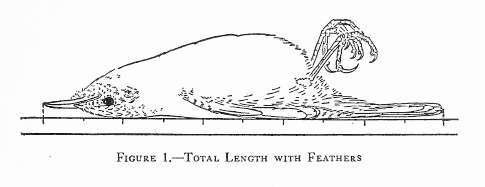
- This is not the “height” of the bird, which on many internet sites seems to mean a measurement from the crown of the head to either the tip of the tail or the bottom of the feet while the bird is perched or standing. This “height” usually is stated as being about 3 feet for a Bald Eagle, although the method of measuring this is rarely specified.
- This measurement can be difficult to obtain with a high degree of accuracy because of variability in stretching the neck. Skin specimens will not give an accurate measurement.
- There are few reported measurements of a Bald Eagle’s length in the ornithological literature.
- Depth of the beak, from the maxilla at the front (anterior) edge of the cere to the opposite point on the lower mandible (© Bortolotti 1984c, Fig. 1c, used by permission).
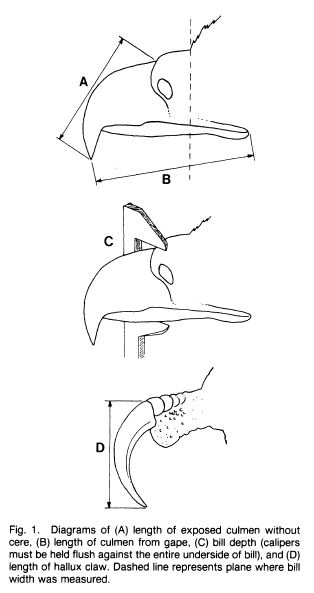
- See the measurement at C.
- The exact place at which this measurement is taken can result in significant variation in the measurement and thus can be unreliable for comparison purposes.
- Specimens can provide accurate readings unless the carcass was dried with the beak open.
- Width of the beak, the widest point where the cere meets the feathers (Figure 13 © Baldwin et al. 1931 as licensed by Creative Commons).
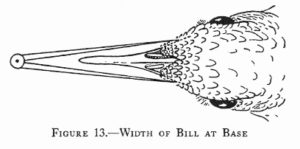
- The exact point at which this measurement is taken can cause significant variation in the reading and thus is not always reliable for comparison purposes.
- Specimens provide less reliable readings.
- Length of the exposed culmen of the beak, the chord of the beak from the tip of the culmen (the curve on the top of the upper mandible) to the front (anterior) edge of the cere, thus the length of the culmen without cere (see above, Bortolotti 1984c, Fig. 1a).
- Length of the beak from the gape, a straight line (chord) from the tip of the upper mandible to the gape or corner of the mouth.
- Specimens provide less reliable readings (see above, Bortolotti 1984c Fig. 1b).
- Length of the foot, or foot pad, the bottom of the foot from the end of the middle toe to the end of the hallux toe, with both toes fully extended and not including the talons (© Bortolotti 1984a, Fig. 1, used by permission).
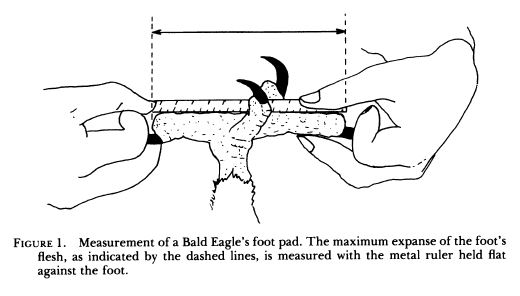
- Taking this measurement on a live bird can be challenging unless the bird is anesthetized and thus relaxed. Specimens usually will not yield accurate results unless the toes were extended during preparation before the skin dries out.
- Tarsus or tarsometatarsus, the “foot” or lowest part of the leg, from which two measurements can be made:
- Length, from the intratarsal joint where the ankle meets the heel to just above the base of the middle toe below the lowest scute (scale) on the leg.
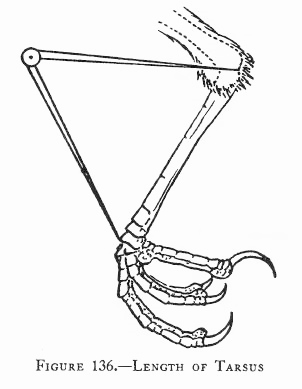 This measurement is a long diagonal from the intratarsal joint at the back of the leg to the base of the toe at the front of the foot. Reports of this measurement can vary, perhaps because of imprecision of identifying the end points. (Figure 136 (© Baldwin et al. 1931 as licensed by Creative Commons).
This measurement is a long diagonal from the intratarsal joint at the back of the leg to the base of the toe at the front of the foot. Reports of this measurement can vary, perhaps because of imprecision of identifying the end points. (Figure 136 (© Baldwin et al. 1931 as licensed by Creative Commons). - Width, which Baldwin et al. 1931 prescribe should be taken at the midpoint of the tarsus.
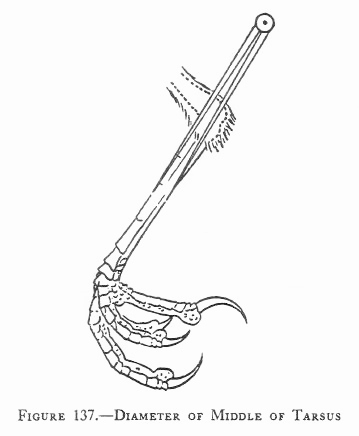 The tarsus is wider when measured from front to back and narrower when measured from one side to the other; generally the front-to-back diameter of the tarsus is measured (Fig. 137 © Baldwin et al. 1931 as licensed by Creative Commons). But the few reported measurements for Bald Eagles are taken just above the toes at the narrowest point of the tarsus, and calculations are of an average of two measurements taken front-to-back and side-to-side, yielding mean width rather than diameter. Either way, width is a highly variable measurement in reports, and specimens do not always yield reliable readings (Bortolotti 1984a and Bortolotti 1984c).
The tarsus is wider when measured from front to back and narrower when measured from one side to the other; generally the front-to-back diameter of the tarsus is measured (Fig. 137 © Baldwin et al. 1931 as licensed by Creative Commons). But the few reported measurements for Bald Eagles are taken just above the toes at the narrowest point of the tarsus, and calculations are of an average of two measurements taken front-to-back and side-to-side, yielding mean width rather than diameter. Either way, width is a highly variable measurement in reports, and specimens do not always yield reliable readings (Bortolotti 1984a and Bortolotti 1984c).
- Length, from the intratarsal joint where the ankle meets the heel to just above the base of the middle toe below the lowest scute (scale) on the leg.
- Middle toe (the 3rd and longest digit), measured from above,
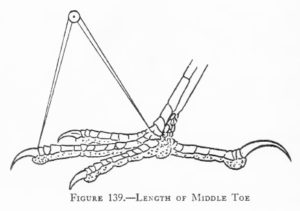 from its base at the metatarsal joint outward to the end of the toe, not including the talon (Fig. 139 © Baldwin et al. 1931 as licensed by Creative Commons).The toe must be extended as straight as possible.
from its base at the metatarsal joint outward to the end of the toe, not including the talon (Fig. 139 © Baldwin et al. 1931 as licensed by Creative Commons).The toe must be extended as straight as possible. - Length of the hallux talon, the chord from the talon’s tip to the point on top where it emerges from the skin of the toe. (see above, Bortolotti 1984c, Fig. 1d).
-
- Specimens can provide reliable readings.
-
- Length of a feather, the chord of the shaft from where it enters
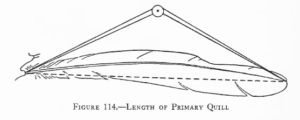 the skin to its tip, without flattening the shaft (Fig. 114 © Baldwin et al. 1931 as licensed by Creative Commons).
the skin to its tip, without flattening the shaft (Fig. 114 © Baldwin et al. 1931 as licensed by Creative Commons).
-
- For Bald Eagles this is usually done only on flight feathers.
- See these photos of Bald Eagle primaries and secondaries from the U.S.F.W.S. Feather Atlas.
-
- Tail, the longest point from the bases of the feathers at the skin to the tips, measured with the tail closed, the ruler placed between the two innermost, or central rectrix, feathers (Fig. 120 © Baldwin et al. 1931 as licensed by Creative Commons).
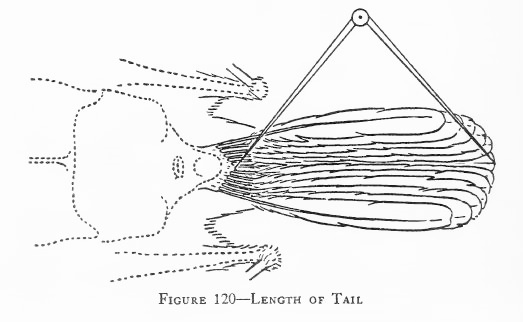
-
- Specimens can give reliable readings of this measurement.
-
- Wing chord, the length of the closed, unflattened wing from the wrist joint to the feather tips (Fig. 101 © Baldwin et al. 1931 as licensed by Creative Commons).
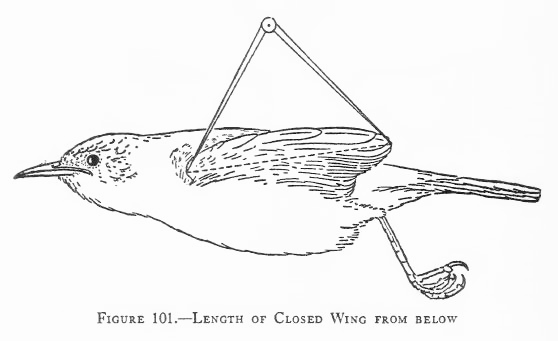
- Some reported Bald Eagle measurements appear to have been taken with flattened wings, hence are longer than measurements of the chord; these are not included here.
- Specimens may not give reliable measurements.
- Wingspan, between the tips of the outstretched wings with feathers, measured with the bird lying flat on its back (Fig. 98 © Baldwin et al. 1931 as licensed by Creative Commons).

- Attempts to measure while the bird is standing or perched are less reliable and consistent.
- Care must be taken not to injure the wings by over-stretching or flattening them.
- Specimens will not give accurate readings.
- There are surprisingly few Bald Eagle wingspan measurements reported in the literature.
MEASURING ADULT, SUBADULT, AND JUVENILE BALD EAGLES
ADULT BALD EAGLE MEASUREMENTS TABLE

You must be logged in to post a comment.